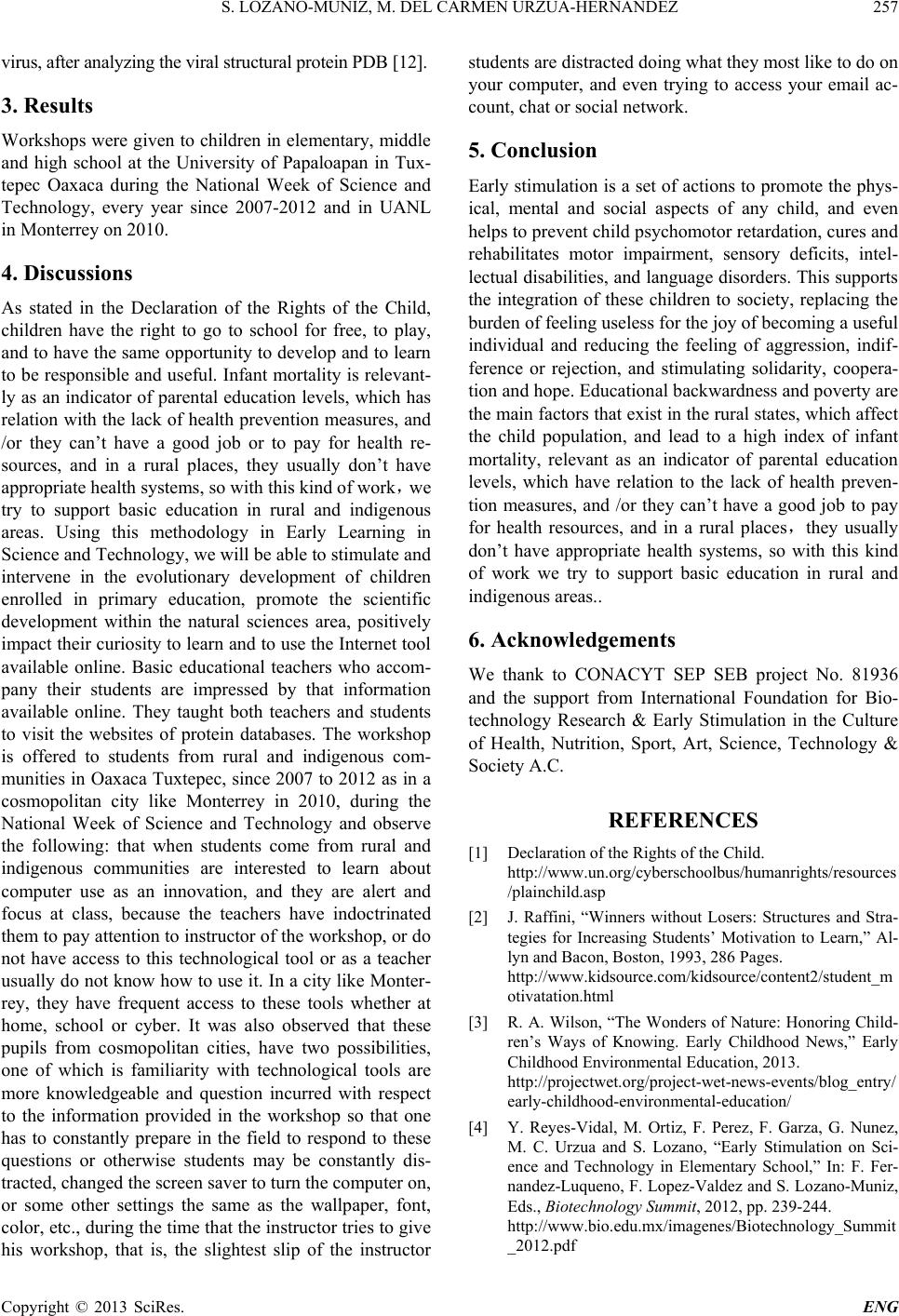
S. LOZANO-MUNIZ, M. DEL CARMEN URZUA-HERNANDEZ
Copyright © 2013 SciRes. ENG
virus, afte r analy zing t he vi ral st ruct ural pr otei n PDB [12].
3. Results
Workshops were given to children in elementary, middle
and high school at the University of Papaloapan in Tux-
tepec Oaxaca during the National Week of Science and
Technology, every year since 2007-2012 and in UANL
in Monterrey on 2010.
4. Discussions
As stated in the Declaration of the Rights of the Child,
children have the right to go to school for free, to play,
and to have the same opportunity to develop and to learn
to be responsible and useful. Infant mortality is relevant-
ly as an indicator of parental education levels, which has
relation with the lack of health prevention measures, and
/or they can’t have a good job or to pay for health re-
sources, and in a rural places, they usually don’t have
appropriate health systems, so with this kind of work,we
try to support basic education in rural and indigenous
areas. Using this methodology in Early Learning in
Science and Technology, we will be able to stimulate and
intervene in the evolutionary development of children
enrolled in primary education, promote the scientific
development within the natural sciences area, positively
impact their curiosity to lear n and to use the Internet tool
available online. Basic educational teachers who accom-
pany their students are impressed by that information
available online. They taught both teachers and students
to visit the websites of protein databases. The workshop
is offered to students from rural and indigenous com-
munities in Oaxaca Tuxtepec, since 2007 to 2012 as in a
cosmopolitan city like Monterrey in 2010, during the
National Week of Science and Technology and observe
the following: that when students come from rural and
indigenous communities are interested to learn about
computer use as an innovation, and they are alert and
focus at class, because the teachers have indoctrinated
them to pay attention to instructor of the workshop, or do
not have access to this technological tool or as a teacher
usually do not know how to use it. In a city like Mon ter-
rey, they have frequent access to these tools whether at
home, school or cyber. It was also observed that these
pupils from cosmopolitan cities, have two possibilities,
one of which is familiarity with technological tools are
more knowledgeable and question incurred with respect
to the information provided in the workshop so that one
has to constantly prepare in the field to respond to these
questions or otherwise students may be constantly dis-
tracted, changed the screen saver to turn the computer on,
or some other settings the same as the wallpaper, font,
color, etc., during the time that the instructor tries to give
his workshop, that is, the slightest slip of the instructor
students are distracted doing what they most like to do on
your computer, and even trying to access your email ac-
count, chat or social network.
5. Conclusion
Early stimulation is a set of action s to promote the phys-
ical, mental and social aspects of any child, and even
helps to prevent child psychomotor retardation, cures and
rehabilitates motor impairment, sensory deficits, intel-
lectual disabilities, and language disord ers. This supports
the integration of these children to society, replacing the
burden of feeling useless for the joy of becoming a useful
individual and reducing the feeling of aggression, indif-
ference or rejection, and stimulating solidarity, coopera-
tion and hope. Educational backwardness and poverty are
the main factors that exist in the rural states, which affect
the child population, and lead to a high index of infant
mortality, relevant as an indicator of parental education
levels, which have relation to the lack of health preven-
tion measures, and /or they can’t have a good job to pay
for health resources, and in a rural places,they usually
don’t have appropriate health systems, so with this kind
of work we try to support basic education in rural and
indigenous areas..
6. Acknowledgements
We thank to CONACYT SEP SEB project No. 81936
and the support from International Foundation for Bio-
technology Research & Early Stimulation in the Culture
of Health, Nutrition, Sport, Art, Science, Technology &
Society A.C.
REFERENCES
[1] Declaration of the Rights of the Child.
http://www.un.org/cyberschoolbus/humanrights/resources
/plainchild.asp
[2] J. Raffini, “Winners without Losers: Structures and Stra-
tegies for Increasing Students’ Motivation to Learn,” Al-
lyn and Bacon, Boston, 1993, 286 Pages.
http://www.kidsource.com/kidsource/content2/student_m
otivatation.html
[3] R. A. Wilson, “The Wonders of Nature: Honoring Child-
ren’s Ways of Knowing. Early Childhood News,” Early
Childhood Environmental Education, 2013.
http://projectwet.org/project-wet-ne ws-e ve nt s/bl og_entry/
early-childhood-environmental-education/
[4] Y. Reyes -Vidal, M. Ortiz, F. Perez, F. Garza, G. Nunez,
M. C. Urzua and S. Lozano, “Early Stimulation on Sci-
ence and Technology in Elementary School,” In: F. Fer-
nandez-Luqueno, F. Lopez-Valdez and S. Lozano-Muniz,
Eds., Biotechnology Summit, 2012, pp. 239-244.
http://www.bio.edu.mx/imagenes/Biotechnology_Summit
_2012.pdf